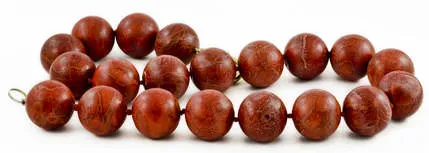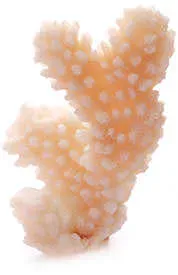 Coral has been used in jewelry for thousands of years. Coral is found in the sea, and is made by small and simple marine invertebrate animals such as coral polyp, which is related to sea anemones. The skeletons of these animals cluster together and build up over thousands of years to become coral colonies, reefs or islands. These colonies grow in branch-like formations. The most famous coral reef is the Great Barrier Reef off Northeastern Australia, which extends for more than 1,250 miles. Most of the coral used since antiquity has been used for ornamental materials. The oldest known finding of red coral dates back to the Mesopotamian civilization, i.e. from about 3000 BC. At the time of Pliny the elder, coral was apparently much more appreciated in India than in Europe. In the 1900's, it was fashionable to marry the humble coral with the world's largest and most precious gemstones, diamonds. Large pieces of coral are relatively rare and are saved for decorative objects or cameos.
Coral has been used in jewelry for thousands of years. Coral is found in the sea, and is made by small and simple marine invertebrate animals such as coral polyp, which is related to sea anemones. The skeletons of these animals cluster together and build up over thousands of years to become coral colonies, reefs or islands. These colonies grow in branch-like formations. The most famous coral reef is the Great Barrier Reef off Northeastern Australia, which extends for more than 1,250 miles. Most of the coral used since antiquity has been used for ornamental materials. The oldest known finding of red coral dates back to the Mesopotamian civilization, i.e. from about 3000 BC. At the time of Pliny the elder, coral was apparently much more appreciated in India than in Europe. In the 1900's, it was fashionable to marry the humble coral with the world's largest and most precious gemstones, diamonds. Large pieces of coral are relatively rare and are saved for decorative objects or cameos.
 Red coral is the most valuable form of coral. The deeper the red, the more it is prized. Skeletons of coral vary in color; from bright to dark red, to slightly orange-red, to pink, black, blue, and white. Each variety of coral has a different amount of translucency. Red, pink, white, and blue (also known as Akori) varieties of coral consist of a substance similar to that of pearls, called calcium carbonate. Akori, or blue coral, is mostly used to make beads. Black coral (also known as Akabar) and golden coral are made out of a mineral called Conchiolin, an organic hornlike substance. Coral is relatively soft, rating only a 3 on the hardness scale, which makes it extremely easy to carve. In general, coral is dull at first, but when polished, it has a lovely vitreous luster. Coral is sensitive to acids and heat however, so its shine may fade with time.
Red coral is the most valuable form of coral. The deeper the red, the more it is prized. Skeletons of coral vary in color; from bright to dark red, to slightly orange-red, to pink, black, blue, and white. Each variety of coral has a different amount of translucency. Red, pink, white, and blue (also known as Akori) varieties of coral consist of a substance similar to that of pearls, called calcium carbonate. Akori, or blue coral, is mostly used to make beads. Black coral (also known as Akabar) and golden coral are made out of a mineral called Conchiolin, an organic hornlike substance. Coral is relatively soft, rating only a 3 on the hardness scale, which makes it extremely easy to carve. In general, coral is dull at first, but when polished, it has a lovely vitreous luster. Coral is sensitive to acids and heat however, so its shine may fade with time.
 There have been many beliefs throughout history at to the positive attributes of coral. It has always been thought to have the power to protect the wearer against evil and enchantments, as well as the power to cure madness. In the 16th century, many people thought a sprig of red or white coral could calm a raging tempest. The Romans believed that red Mediterranean coral had magical and medicinal properties and Roman children wore coral necklaces to protect them from danger and keep them healthy. Victorian babies from wealthy families had teething rings made of coral. And Native American artisans also created fine jewelry from coral.
There have been many beliefs throughout history at to the positive attributes of coral. It has always been thought to have the power to protect the wearer against evil and enchantments, as well as the power to cure madness. In the 16th century, many people thought a sprig of red or white coral could calm a raging tempest. The Romans believed that red Mediterranean coral had magical and medicinal properties and Roman children wore coral necklaces to protect them from danger and keep them healthy. Victorian babies from wealthy families had teething rings made of coral. And Native American artisans also created fine jewelry from coral.
 Coral exists in warm waters from 20 to 1,000 feet deep, with the best quality coral found from 100 to 160 feet. Japanese coral is red, pink, or white. Red and pink coral can also be found on the Mediterranean and African coasts, the Red Sea, and in the waters off Malaysia and Japan. Black and golden coral are found off the coasts of the West Indies, Australia, and the Pacific islands.
Coral exists in warm waters from 20 to 1,000 feet deep, with the best quality coral found from 100 to 160 feet. Japanese coral is red, pink, or white. Red and pink coral can also be found on the Mediterranean and African coasts, the Red Sea, and in the waters off Malaysia and Japan. Black and golden coral are found off the coasts of the West Indies, Australia, and the Pacific islands.